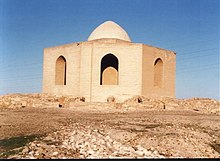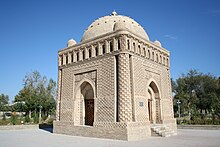Qubba
قُباب qubāb),[3] also transliterated as ḳubba, kubbet and koubba, is a cupola or domed structure, typically a tomb or shrine in Islamic architecture.
[6][7][1] The Arabic word qubba was originally used to mean a tent of hides,[8] or generally the assembly of a material such as cloth into a circle.
[3] In early Islamic culture, the construction of mausoleums and ostentations tomb structures to commemorate the deceased was viewed as unorthodox, as Muhammad himself opposed such practices.
[2][3] However, historical records indicate that from the 8th century onward mausoleums became common, propagated in part by their popularity among the Shi'a, who built tombs to commemorate the Imams which in turn became places of religious ceremony and pilgrimage.
[2][3] The oldest surviving example of a domed tomb in Islamic architecture is the Qubbat al-Sulaibiyya in Samarra, present-day Iraq, dating from the mid-9th century.


